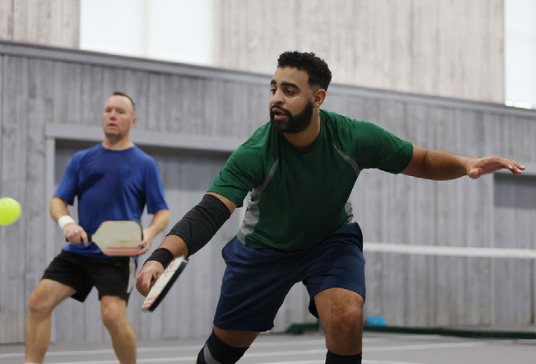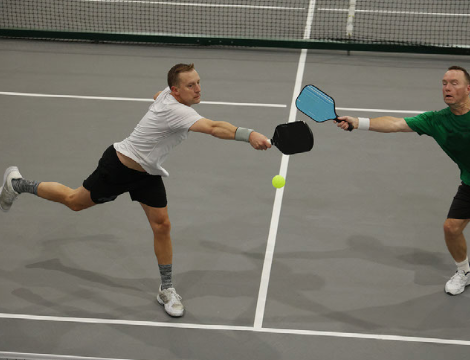Last Updated on November 20, 2025 by Drew Pierce
My paddle is poised, my eyes alert.
I’m in that familiar position that I’ve spent hundreds of hours in over the past 16 months, dancing on the edge of the Non-Volley Zone line.
In the tactical sport of pickleball, dinking is the backbone of the game. But how do you polish this essential skill into a lethal weapon that wins you points?
With doubles often morphing into a psychological warzone when you’re embroiled in a dinking duel with your opponents, how can you outwit and outplay them? Let’s uncover some solid strategies and tips to help you win the dink.
Prefer to listen to this post? Click below:
Dink Rally Tip 1: Dominate the Air in the Kitchen
When you find yourself volleying at the Kitchen, try to strike the pickleball mid-air whenever possible. This strategy reduces the time your opponents have to respond and constricts their options to place return shots.
Additionally, by striking the ball on the fly, you can thwart tricky spins and unusual bounces by keeping the ball from hitting the ground. Remember not to overreach! Instead, either take a step back so you can hit the ball at its highest point or hold your ground.

Dink Rally Tip 2: It’s Okay to Retreat (Briefly!)
Keeping your feet glued to the Non-Volley Zone line is essential since stepping back opens up more court for your opponents to play with.
However, pickleball, like life, isn’t always about rigid rules. If a well-aimed shot targets your feet or a fastball demands more reaction time, don’t hesitate to take a tiny step back. This move can give you the necessary space and time to counter effectively. Remember, it’s all about playing smart!
One critical note to remember if you do step back – quickly step back in immediately after executing your shot. Holding the line is crucial, and moving back up to the Non-Volley Zone line right after your shot is part of that strategy.
Dink Rally Tip 3: Practice the Art of Patience
Dink duels demand a considerable amount of patience to come out victorious. As the exchange of dinks persists, the tension amplifies, and the temptation to attempt a winner by accelerating play can become irresistible. However, hastily speeding up an unattackable shot will often result in losing the rally, whether by directing the pickleball into the net, smacking it out of bounds, or serving it directly to your opponents for an effortless counterattack. Exercise patience and gradually construct your play by delivering quality shots that pressure your opponents, compelling them to return a less-than-perfect shot.
Dink Rally Tip 4: Teamwork! Be a Well-Oiled Machine
In pickleball doubles, the effectiveness of your teamwork is essential to taste victory. To accomplish a smooth partnership, there are a couple of key aspects you and your mate will need to master:
When you and your partner are engrossed in a dink exchange at the Kitchen line, imagine yourselves as dancers, moving gracefully across the stage, mirroring each other’s movements. Typically, you and your partner should maintain a distance of about six to eight feet while at the Kitchen line. Visualize an invisible tether, spanning six to eight feet, that connects you two. Your movements should mirror each other’s: if one moves, the other should follow suit.
You also must engage in active communication. Verbally exchanging cues and words with your partner on the pickleball court—utterances like “Mine,” “Me,” “You,” “I got it,” or “Yours” can avoid mishaps. Also, given that forehand shots generally pack more power and reliability than backhand shots, the rule of thumb suggests the player with a forehand opportunity down the middle should seize the shot.

Dink Rally Tip 5: Keep Them Guessing
Dinking in pickleball isn’t about monotony, it’s about spicing things up, moving your shots around, and keeping your opponents guessing. This involves experimenting with different spins, speeds, angles, depths, and placements. The more unpredictable you are, the more disoriented your opponents will be, caught off guard on their side of the court, unsure of who should take the shot or how to react to your array of dinks. Here are a few dink options:
- Crosscourt Dinks – Crosscourt dinks are usually the go-to, primarily because they provide a wider margin for error. This is because the lowest part of the net is in the middle, the angle comes naturally, and there’s more court space to exploit on your opponents’ side of the Non-Volley Zone. Thus, these dinks are more forgiving, demanding less perfection.
- Down-the-Line Dinks – Despite the advantages of the crosscourt dink, consistently hitting them might put unnecessary pressure on you, and risks becoming too predictable. To keep your opponents on their toes, consider aiming down the middle of the court or down your side of the court. This not only moves your opponents around but also stops them from cheating to one side. Under pressure, these down-the-line dinks are often easier to execute successfully. So if you struggle to return strong or well-placed shots crosscourt, use these shots as a lifeline. Also, go down the line when you notice a gap caused by your opponents shifting too far one way. But choose your moments wisely; your opponents might be waiting to pounce on these shots (advanced players might even pull out an Erne shot on you!).
- Middle Dinks – Serving up a dink right in the middle can cause havoc between your opponents, especially when they’re new partners. Middle dinks are also an effective tool for creating space on the court. If you serve a dink down the middle, both opponents tend to step toward it. Upon their return, you now have more room to aim toward the sidelines. They shift to reach your shot, creating even more space in the middle. See the pattern? Middle dinks help you expose the gaps on the court. Furthermore, they’re useful to avoid an Erne if your opponents are advanced players.
- Dinks at Your Opponents’ Feet – Aiming your dinks at your opponents’ feet, whether crosscourt, down-the-line or down the middle, is a pressure tactic. It’s challenging for opponents to return a ball aggressively when it’s at their feet, as they can’t hit it out in front of their bodies.
- Dinks to Backhands – Many players have weaker backhand shots compared to forehand shots. Thus, aiming your dinks at your opponents’ backhands is a common yet effective strategy.
The art of dinking in pickleball is more than just a set of skills—it’s a series of tactics, timing, patience, and team dynamics. By mastering these strategies, from controlling the airspace in the Kitchen, dancing in tandem with your partner, to varying your dink placements, you set the stage for a game well played.
Try incorporating these techniques into your game each time you step onto the court. Don’t be discouraged if you fail initially—dinking is a nuanced skill that takes time to perfect. Yet, with patience and persistence, you’ll not only win the dink but also gain an edge in the psychological battle that often ensues in a match.
